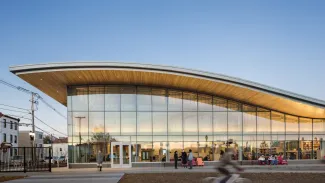Where we stand: Buildings are infrastructure
Like our bridges and highways, America’s public buildings are crumbling. Every year that we put off necessary repairs and renovations, we increase costs to taxpayers. Every time we repeal building codes that require structures to be more secure and resilient, we endanger life and property.

Conversation about our nation’s infrastructure must include buildings
Unless we include buildings in the discussion about our nation’s infrastructure renewal, taxpayers will be stuck with decrepit community places, higher bills when repairs come due and structures vulnerable to disasters and threats.
Buildings are just as vital to our safety, security and sustenance as roads, bridges and mass transit systems. In fact, a poll commissioned last year by The American Institute of Architects found that more than 80% of Americans see public buildings as part of the nation’s infrastructure. Schools, for example, are the second largest public infrastructure investment after transportation.
As architects and designers, we uphold the following principles.
- Infrastructure includes the public buildings that house our schools, courts, libraries, community centers and affordable housing. Any conversation about investing in the nation’s infrastructure must include the structures that connect Americans.
- Buildings must be a part of the infrastructure debate. Nearly all Americans (94%) agree that well-supported and maintained public buildings are important to their communities. Voters must expect policymakers to make the places where they meet, learn, and conduct other business a part of any 21st century American infrastructure renewal.
- New infrastructure must be resilient to a changing climate. The world has changed. Sea levels are rising, disasters and threats are increasing. Public buildings that can mitigate the damage from extreme weather and other threats are not today’s regulatory burdens, but tomorrow’s assets.
- Building codes are the foundation of a resilient, safe infrastructure. We must fight efforts to weaken building codes in the quest for short-term profits. These efforts endanger life and property and jeopardize the built environment’s ability to withstand extreme weather events, devastating fires, and seismic and geologic events.
- We've built infrastructure before; we can do it again. Existing policies are already in place that can leverage billions of dollars in federal money to spur state and local infrastructure projects like schools, libraries and community centers. The Energy Efficient Commercial tax deduction alone has created millions of jobs and billions of dollars in GDP while helping local governments design buildings that save taxpayers and communities money.
- Good design yields big returns on infrastructure investment. Studies show that for every dollar spent on buildings to mitigate hazards, society saves $4 in return. Almost 40 percent of all US energy is consumed by buildings that produce carbon through heating, cooling, and lighting and through their construction. Smart design that conserves energy not only reduces demand on our energy infrastructure but lowers Americans’ tax bills.
- Infrastructure must secure and unite. Innovative design techniques for public structures like U.S. embassies, promenades and borders can secure our nation’s most important spaces while enabling a free and open society. Every day that America neglects its buildings is another day that future generations are burdened by our failure to plan and design.
Whether we live in big cities or small towns, Americans have the right to quality schools, hospitals, and libraries—all the infrastructure that shelter, protect and uplift our communities. The infrastructure we design today must be one that is worthy of passing down to our children tomorrow.
